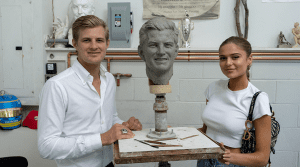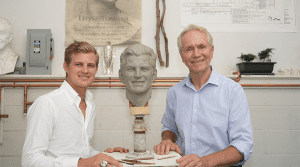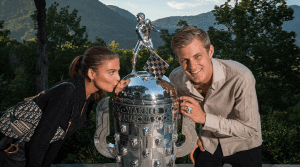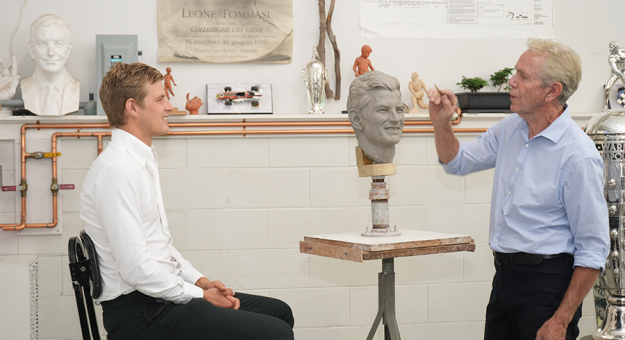TRYON, N.C. — On the last official day of summer, what better way to spend a Tuesday afternoon than in this picturesque community located in the foothills of the Blue Ridge Mountains.
It’s an area of scenic beauty with hillside resorts, quaint lodges that haven’t been renovated since actor David Niven was a regular visitor to Tryon throughout the British actors famed career.
But on this day, the star attraction was from Sweden.
It was Marcus Ericsson, the winner of the 106th Indianapolis 500 on May 29 along with his Danish girlfriend, Iris Tritsaris.

The 32-year-old IndyCar driver for Chip Ganassi Racing was in town spending the day with famed artist and sculptor William Behrends, who since 1990 has created the face of the winning driver of the Indianapolis 500 that is attached to the Borg-Warner Trophy.
The process actually begins the morning after the Indianapolis 500, when Behrends compiles photos of the winning driver from various angles that he studies before creating a life-size clay sculpture of his head.
Tuesday at his studio at his spectacular mountain estate, Behrends’ took the wraps off Ericsson’s clay head to the amazement of the driver and his girlfriend.
“Marcus, this is the clay study I did of you from the photographs we took the day after the race,” Behrends said as he removed the wraps. “We’re going to work on this together.”
A big smile came across Ericsson’s face. Tritsaris’ eyes grew with amazement.
“That is great,” Ericsson said. “Amazing. Good job. I think it’s amazing. It’s a bit weird seeing myself. I can definitely see that it’s me, but it’s amazing to see it.
“I think that is so cool.”
Tritsaris said, “It’s so good. It is definitely you.”
“This looks better than real, that’s amazing,” Ericsson said. “It looks really, really good. It’s amazing.
“It looks better than the real Marcus.
“I don’t want to say better than expected because I expected it to be great. I think it’s amazing. It’s even more real than I expected. I know how good William is, but it’s not until you see one of yourself that you realize how very good it is.
“It’s really good.”
This part of the process is relatively new. It began with Juan Pablo Montoya, after he won his second Indianapolis 500 in 2015. Montoya was the first driver to come to Behrends’ studio to sit in while the sculptor worked on the finer details of Montoya’s face.
Thanks to BorgWarner, which unveiled the permanent Borg-Warner Trophy at the 1935 Indianapolis 500, the live study has continued with 2016 winner Alexander Rossi, Takuma Sato in 2017 and 2020, Will Power in 2018, Simon Pagenaud in 2019 and Helio Castroneves in 2021.
Behrends has created the face for every driver on the Borg-Warner Trophy since Arie Luyendyk won his first Indianapolis 500 in 1990.
“So, how do you start?” Ericsson asked Behrends.
“You try to get the proportions right,” Behrends explained. “If you do something and it’s not positioned right, you can do it all over again in clay. But you are really conscious of the proportions and having a good foundation.
“I like the clay to be as soft as possible because it helps when you make changes. When you look at a face, the profile is the most important thing you see. A good, strong profile is very important.”
Ericsson remarked about the detail of his hair and how it is longer now. The driver had shorter hair during the race, but not by much.
Behrends will use the full-size, clay head when he starts the process of the wax process. He uses the larger head as a reference point when he starts the meticulous process of reducing the face to about the size of an egg.
“I will start over again, so I use this to study the face,” Behrends said. “I do everything the old-fashioned way. I’m very unusual for a sculptor, I don’t use 3-D scans.
“What I do can take a year to finish.”

Once the wax process is completed, he will use the same type of plaster that is used for dental molds. From there, a bass-relief image is cast in Sterling Silver.
When Behrends gets that back from the silversmith, he is able to put the final touches on that Sterling Silver face with the very small sculpting tools that he uses.
At that point, the face is then attached to the trophy and is usually unveiled sometime in late November or early December.
There is a possibility the Borg-Warner Trophy could travel to Sweden, but those discussions and details have not been completed. The Borg-Warner Trophy traveled to Japan with Sato after his first Indy 500 win in 2017 and went to France with Pagenaud when he won the Indianapolis 500 in 2019.
“Really good job,” Ericsson told Behrends. “I’m very impressed.”
Behrends was making notes for the structure of Ericsson’s face such as bone structure and forehead.
Ericsson asked Behrends questions about the process and marveled at how well the sculptor is at his craft.
“It’s really a process of memorizing the face,” Behrends said. “To have a clay head as a reference point is very important.”
Next year will be Behrends’ 50th year as a sculptor.
“I was always involved in art,” Behrends said. “I drew and did a lot of two-dimensional art, but my father was a builder, and I was able to apply that to building.
“On the Borg-Warner Trophy, I always try to do a better job than the one I did last year. But every one of these that I do is unique. I want each one to be very distinctive in their own way.
“I want somebody standing 20 feet away to look at the trophy and say, ‘That’s Marcus Ericsson’s face.’ I want it to stand out.”
From the egg-sized faces on the Borg-Warner Trophy, Behrends has also created larger than life statues that stand outside of Oracle Park, home of the San Francisco Giants, Petco Park, home of the San Diego Padres, and Dodger Stadium. The statues immortalize the great players from those teams.
His latest baseball statue was unveiled in April when Behrends created a statue of New York Mets pitcher Tom Seaver at CitiField in Flushing Meadow, New York.
Behrends has also been commissioned to create statues of Vice Presidents of the United States that are on display at the United States Capitol Building.
When Behrends was growing up in Wisconsin, the first Indianapolis 500 that he remembers was Parnelli Jones victory in 1963.
“I’ve been a fan ever since,” Behrends said.
For Ericsson, it was Kenny Brack becoming the first driver from Sweden to win the Indianapolis 500 in 1999.
“I was eight or nine years old when I have my first memories of IndyCar racing,” Ericsson recalled. “I still have memories of sitting late at night on Sunday nights with my dad watching on Swedish television because Kenny Brack was very big in Sweden. They were broadcasting the Indy 500 and IndyCar races live on Swedish TV. I have memories of watching Kenny Brack on TV with my dad.
“That stuck in my head when my Formula One career ended. I told my manager we need to find a way to get to IndyCar. I had sports car opportunities, but I wanted to do IndyCar and I wanted to do the Indianapolis 500.
“I’m glad that I did.”
It has certainly paid off for Ericsson, who drove the No. 8 Huski Chocolate Chip Ganassi Racing Honda to victory in a thrilling 106th Indy 500 on May 29. He fought his way to the lead, had to endure a red flag period late in the race that took away his lead, then fight off a charging Pato O’Ward of Arrow McLaren SP Racing at the end of the race.
The Chip Ganassi Racing driver that many race fans had overlooked entering the race, won the biggest race of his career and changed his life forever.
He shared the victory with his girlfriend in victory lane and both kissed the “Yard of Bricks” afterwards.

On Tuesday in Tryon, Tritsaris looked adoringly at her boyfriend and compared it with the clay head that Behrends had completed.
She planted a kiss on the clay head after kissing her boyfriend.
This was the first time Behrends had the winning driver’s wife or girlfriend joined them at the studio and in many ways, the college student from Denmark added her own special mark to the festivities.
Tritsaris is also a professional model, and her kisses would leave their mark on the day.
After the live study at Behrends’ studio was completed, Ericsson and the Borg-Warner Trophy moved to the outside of the Tryon Theater in this artsy resort community that bills itself as the “Friendliest Town in the South.”
Fifty years ago, David Niven’s arrival in Tryon was big news because he was a famous international actor.
On Tuesday, it was Ericsson who had his name in bright lights on the Tryon Theater marquee.
“BorgWarner Congratulates 2022 Indy 500 Winner Marcus Ericsson. Chip Ganassi Racing. Huski Chocolate.”
To complete the theater theme was a giant box of popcorn. The two playfully tossed popcorn at each other, one kernel at a time, trying to get it into each other’s mouth like a basketball going through the hoop.
When it was all over, Tritsaris planted a kiss on top of the Borg-Warner Trophy, leaving a lipstick stain on top of the famed Sterling Silver trophy.
It was a unique ending to close out the final day of Summer in the North Carolina mountains.
